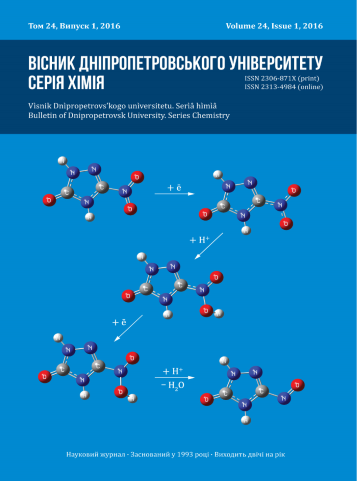Two-electron reduction of nitroaromatic compounds by flavin mononucleotide. DFT computational study
DOI:
https://doi.org/10.15421/081601Keywords:
nitroaromatics, reduction, flavin mononucleotide, DFTAbstract
The mechanism for reduction of nitroaromatic compounds by flavin mononucleotide (FMN) was examined at MPWB1K/tzvp level. The solvent effects were calculated using a PCM(Pauling) and SMD(Pauling) solvation models for ions and neutral molecules, respectively. Calculated thermodynamics of the reduction of nitro group to nitroso group suggests consequtive four-steps’ process (electron–proton–electron–proton transfer) where the first proton comes from solution, while the second one – from FMN. Water molecule releases during fourth step of the process. Electron attachment to nitrocompound and electron lose by reduced FMN facilitate the breaking of N–O bond and proton release, respectively. Calculations show that reduction of nitro group to nitroso group in studied nitrocompounds is a thermodynamically feasible with 56–59 kcal/mol Gibbs free energy release. The most easy electron transfer proceeds for TNT (2,4,6-trinitrotoluene) and NTO (5-nitro-2,4-dihydro-3H-1,2,4-triazol-3-one). While the most energy release occurs during proton transfer in case of ANTA (5-amino-3-nitro-1H-1,2,4-triazole).
References
Esteve-Nunez, A., Caballero, A., Ramos, J. L. (2001). Biological Degradation of 2,4,6-Trinitrotoluene. Microbiol. Mol. Biol. Rev., 65(3), 335-352.
Kitts, C. L., Green, C. E., Otley, R. A., Alvarez, M. A., Unkefer, P. J. (2000). Type I nitroreductases in soil enterobacteria reduce TNT (2,4,6-trinitrotoluene) and RDX (hexahydro-1,3,5-trinitro-1,3,5-triazine). Can. J. Microbiol., 46, 278–282.
Parkinson, G. N., Skelly, J. V., Neidle, S. (2000). Crystal structure of FMN-dependent nitroreductase from Escherichia coli B: a prodrug-activating enzyme. J. Med. Chem., 43, 3624–3631.
Christofferson, A., Wilkie, J. (2009). Mechanism of CB1954 reduction by Escherichia coli nitroreductase. Biochem. Soc. Trans., 37, 413–418.
Salazar-Salinas, K., Seminario, J. M. (2010). Energetics and Vibronics Analyses of the Enzymatic Coupled Electron–Proton Transfer From NfsA Nitroreductase to Trinitrotoluene. IEEE Transactions on Nanotechnology, 9(5), 543–553.
Frisch, M. J., Trucks, G. W., Schlegel, H. B., Scuseria, G. E., Robb, M. A., Cheeseman, J. R., Scalmani, G., Barone, V., Mennucci, B., Petersson, G. A., Nakatsuji, H., Caricato, M., Li, X., Hratchian, H. P., Izmaylov, A. F., Bloino, J., Zheng, G., Sonnenberg, J. L., Hada, M., Ehara, M., Toyota, K., Fukuda, R., Hasegawa, J., Ishida, M., Nakajima, T., Honda, Y., Kitao, O., Nakai, H., Vreven, T., Montgomery, Jr., J. A., Peralta, J. E., Ogliaro, F., Bearpark, M., Heyd, J. J., Brothers, E., Kudin, K. N., Staroverov, V. N., Kobayashi, R., Normand, J., Raghavachari, K., Rendell, A., Burant, J. C., Iyengar, S. S., Tomasi, J., Cossi, M., Rega, N., Millam, J. M., Klene, M., Knox, J. E., Cross, J. B., Bakken, V., Adamo, C., Jaramillo, J., Gomperts, R., Stratmann, R. E., Yazyev, O., Austin, A. J., Cammi, R., Pomelli, C., Ochterski, J. W., Martin, R. L., Morokuma, K., Zakrzewski, V. G., Voth, G. A., Salvador, P., Dannenberg, J. J., Dapprich, S., Daniels, A. D., Farkas, Ö., Foresman, J. B., Ortiz, J. V., Cioslowski, J., & Fox, D. J. (2009). Gaussian 09 (Revision A.02) [Computer software]. Gaussian Inc., Wallingford CT.
Zhao, Y., Truhlar, D. G. (2004). Hybrid Meta Density Functional Theory Methods for Thermochemistry, Thermochemical Kinetics, and Noncovalent Interactions: The MPW1B95 and MPWB1K Models and Comparative Assessments for Hydrogen Bonding and van der Waals Interactions. J. Phys. Chem. A, 108(33), 6908–6918.
Weigend, F., Ahlrichs, R. (2005). Balanced basis sets of split valence, triple zeta valence and quadruple zeta valence quality for H to Rn: Design and assessment of accuracy. Phys. Chem. Chem. Phys., 7, 3297–3305.
Sviatenko, L., Isayev, O., Gorb, L., Hill, F., Leszczynski, J. (2011). Toward robust computational electrochemical predicting the environmental fate of organic pollutants. J. Comput. Chem., 32, 2195–2203.
Cossi, M., Scalmani, G., Rega, N., Barone, V. (2002). New developments in the polarizable continuum model for quantum mechanical and classical calculations on molecules in solution. J. Chem. Phys., 117, 43–54.
Marenich, A. V., Cramer, C. J., Truhlar, D. G. (2009). Universal solvation model based on solute electron density and on a continuum model of the solvent defined by the bulk dielectric constant and atomic surface tensions. J. Phys. Chem. B, 113, 6378–6396.
Downloads
Published
Issue
Section
License
Copyright (c) 2016 Oles Honchar Dnipropetrovsk National University

This work is licensed under a Creative Commons Attribution 4.0 International License.
- Authors reserve the right of attribution for the submitted manuscript, while transferring to the Journal the right to publish the article under the Creative Commons Attribution License. This license allows free distribution of the published work under the condition of proper attribution of the original authors and the initial publication source (i.e. the Journal)
- Authors have the right to enter into separate agreements for additional non-exclusive distribution of the work in the form it was published in the Journal (such as publishing the article on the institutional website or as a part of a monograph), provided the original publication in this Journal is properly referenced
- The Journal allows and encourages online publication of the manuscripts (such as on personal web pages), even when such a manuscript is still under editorial consideration, since it allows for a productive scientific discussion and better citation dynamics (see The Effect of Open Access).


